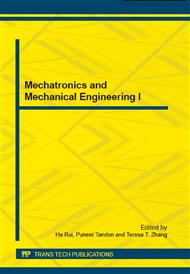[1]
He Zhengqin, Ye Tailan, Ding Zhifeng, Sun Weiguo. The application of shallow seismic prospecting methods to active fault detection if cities. 2001, (1): 1-6.
Google Scholar
[2]
Yu Shuibao, Li Minghua, Lu Zhenhong. Rearch of frequency bandspread of magnet-electrical absolute vibration velocity transducer. Journal of Zhejiang Normal University(Nat. Sci. ), 1999, 22(1): 22-27.
Google Scholar
[3]
Jia hui, He Zhenqin, Ye Tailan. Application of SASW and MASW to buried fault detection. Progress in Geophys, (in Chinese), 2010, 25(2): 709-713, DOI: 10. 3969/j. issn. 1004-2903. 2010. 02. 046.
Google Scholar
[4]
Sun Yongjun, Xu Peifeng, Lin Squn, Li Chuangjin. Microtremor survey method and its progress. Progress in Geophys. (in Chinese), 2009, 24(1): 326-334.
Google Scholar
[5]
Hagami H, Duke C M, Liang G C, Ohta Y. Evaluation of site effect upon seismic wave amplification due to extremely deep soil deposits. Bull. Seism. Soc. Am., 1982, 72: 987-998.
DOI: 10.1785/bssa0720030987
Google Scholar
[6]
Wang Weijun, Liu Lanbo, Chen Qifu, Zhang Jie. Applications of microtremor H/V spectral ratio and array techniques in assessing the site effect and near surface velocity structure. Chinese J. Geophys. (in Chinese), 2009, 52(6): 1515-1525, DOI: 10. 3969/j. issn. 0001-5733. 2009. 06. 013.
Google Scholar
[7]
Kase. S, Katon.J. A seismic displacement sensor for rotarional vibration with measuring range enlarged to the low-frequency region. Transactions of the Japan Society of Mechanical Engineers. C, 1990, 56(524): 906-910.
DOI: 10.1299/kikaic.56.906
Google Scholar
[8]
Henri P. Gavin, Rodrigo Morales, Kathryn Reilly. Drift-free integrators. Review of Scientific Instruments, 1998, 69(5): 2171-2175.
DOI: 10.1063/1.1148918
Google Scholar
[9]
E.J. Rogers. Integrator for small pulsed and direct currents. The Review of Scientific Instruments, 1963, 34(6): 660-663.
DOI: 10.1063/1.1718533
Google Scholar
[10]
J.G. Bak, S.G. Lee, and the KSTAR Project Team. Performance of the magnetic sensor and the integrator for the KSTAR magnetic diagnostics. Review of Scientific Instruments, 2004, 75(10): 4305-4307.
DOI: 10.1063/1.1789620
Google Scholar
[11]
Hu Xingxing, Teng Yuntian, Xie Fan, Wang Xizhen, Li Caihua, Wang Xiaomei. Research on MEMS velocity seismometer technology. Progress in Geophysics, 2013, 28(1): 515-522.
Google Scholar
[12]
Wei Yongqing, Xie Jikang, Wan Baonian, Shen Biao. A chopper-stabilized long pulse integrator with low drift. Nuclear Fusion and Plasma Physics, 2006, 26(3): 246-251.
Google Scholar
[13]
Wu Zhaofang. Auto-compensation of the integrator's drift. Journal of Anqing Teachers College (Natural Science Edition), 2008, 14(2): 28-30.
Google Scholar
[14]
E. J. Strait, J. D. Broesch, R. T. Snider, M. L. Walker. A hybrid digital-analog long pulse integrator. Rev. Sci. Instrum. 1997, 68(1): 381-384.
DOI: 10.1063/1.1147835
Google Scholar
[15]
J. G. Bak, S. G. Lee. Analog integrator for the Korea superconducting tokamak advanced research magnetic diagnostics. Review of Scientific Instruments, 78, 043504 (2007).
DOI: 10.1063/1.2721405
Google Scholar
[16]
Li Xiangyang, Zhou Jing, Dong Wei. Design of high precision and low drift electronic integrator. China Measurement Technology, 2007, 33(6): 137-140.
Google Scholar
[17]
Liu Dongmei, Wan Baonian, Shen Biao. Design of a long pulse and low drift analog integrator in HT-7. Nuclear Electronics & Detection Technology, 2007, 27(3): 447-469.
Google Scholar
[18]
Wang Yong, Ji Zhenshan, Luo Jiarong. Design of low drift integrator with auto-compensation. Computer Measurement $ Control, 2006, 14(4): 530-532.
Google Scholar
[19]
Giovanni Romeo. Whale watching: effects of strong signals on Lippmann style seismometers. Journal of Seismology, 2012, 16(1): 25-34. DOI: 10. 1007/s10950-011-9246-7.
DOI: 10.1007/s10950-011-9246-7
Google Scholar
[20]
Romeo, G. and Spinelli, G.: Extending a Lippmann style seismometer's dynamic range by using a non-linear feedback circuit, Adv. Geosci., 36, 27-30, doi: 10. 5194/adgeo-36-27-2013, (2013).
DOI: 10.5194/adgeo-36-27-2013
Google Scholar


